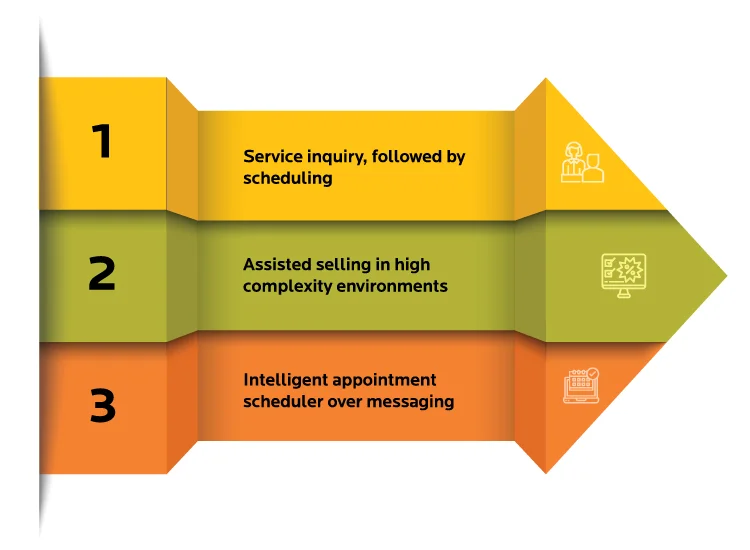The experience that conversational commerce aspires to deliver, can at best, be summarized as a low-touch white-glove service, and at the least, an agile, fast, and personalized way to fulfill a customer’s need embedded within a context. This is made possible by using digital technologies like conversational AI that are interfaced with customer-facing technologies - like virtual home assistants and messaging apps like WhatsApp and Facebook Messenger. Conversational commerce can help alleviate some of the critical challenges of buying through websites and apps and reduce the cost of selling non-standard products and services. Read on to understand the why, what, and how of conversational commerce.
The Rise of Conversational Commerce
In the early 2000s, selling products and services using a website was all the craze. When smartphones gained popularity, creating an interface to the e-store using an app or a mobile-compatible website took to the forefront. Today, the reducing cost of sensors, increasing permeability of high-speed connectivity, and an expanding device footprint - have collectively enabled enterprises to rethink how they sell their products and services to the end customer. And this trend is no longer limited to retailers or B2C companies. Conversational commerce has now become a valuable tool in the enterprise’s customer experience toolkit.
Top Market Trends
Some of the first adopters of conversational commerce were Dominos (which launched a voice-enabled ordering interface on its mobile app) and retailers like Walmart, Costco, and Walgreens. Since then, conversational commerce has evolved to serve multiple functions - like assisted selling through conversational chatbots that serve as virtual assistants on websites and apps on connected home devices that can sail through the order and handle it end-to-end, from discovery to payment and tracking.
Adoption Curve
While over 40 large retailers have adopted conversational commerce in the US alone, the technologies that constitute conversational commerce are already present in various settings today. For example, most IT departments use a chatbot today, self-service portals are being interfaced with intelligent search technologies, and almost 58% of enterprises investing in chatbots are B2B companies.
The adoption curve has shown a steep rise on both sides - customers show a greater comfort with interacting with their voice assistants for ordering a meal, booking a taxi or an appointment, or making payments for services. At the same time, enterprises are expanding the capabilities of their informational chatbots to do more. For example, a B2B Nordic bank recently expanded its chatbot’s capabilities from merely disseminating information about its policies and product offerings to handle mortgage broker requests from customers.
Market Potential
As Artificial Intelligence (AI) technologies like Natural Language Processing (NLP) make further advancements, the capabilities and potential of these front-facing chatbots and intelligent voice systems will only move upwards.
An increasing maturity factor in enterprise technology and cross-functional integrations between software systems will ultimately open up conversational front-ends to the orchestration of customer queries and requests downstream.
However, there is a soft side too to conversational commerce - some of the most successful use cases have demonstrated the value of making AI-backed conversations human-like, demonstrating emotional intelligence and context-awareness through interactions, and adapting to multiple personas in multi-user device environments. While some features do exist in the labs, only a few early adopters have commercialized and rationalized the spend on such advanced capabilities.
Today, over 66% of internet users have already interacted with chatbots, and half are satisfied with them. And by 2023, over $112 bn will be spent through chatbot-powered e-commerce transactions, according to a study. In the coming years, conversational commerce is expected to disrupt almost every industry - an increasing intelligence and skill factor on virtual home assistants like Amazon Alexa, Apple Siri, Google Assistant, and Microsoft’s Cortana, coupled with the 99%+ accuracy of speech-to-text technologies - only consolidates the case for investing in conversational commerce.
How Conversational Commerce Works?
Conversational commerce is supported by several technologies, which are leveraged in a channel-appropriate manner, and integrated with the enterprise technology depending on the expectations from their deployment.
Deep Dive
Conversational commerce essentially automates interactions between a customer and the enterprise by emulating human-like conversations through various media - for example, an app inside a physical outlet, over a voice through a connected home device, messaging apps, car infotainment systems. Such systems usually consist of an interface that allows the customer to interact with the brand. The customer’s responses are converted into text, which is then processed using NLP.
This is how the customer’s intent is inferred, following which human-like responses to a query are generated and rendered in text or voice. Conversational commerce is based on loosely modeled customer journeys that inform the conversation flow design - that sits at the core of such a system. When integrated with the enterprise CRM and ERP systems and automated revenue/quote-to-cash software, such a system can orchestrate a fast and highly responsive sales experience end-to-end for both the customer and the enterprise.
Typical Digital Levers For Conversational Commerce
Conversational commerce can be deployed across a variety of channels. Here are three typical levers that demonstrate high RoI on deployment from day one:
Chatbots
Over 74% of customers prefer using chatbots when hunting for answers, and 69% feel comfortable handling issues without human agents backing them up. This comfort with chatbots is being leveraged to guide assisted sales on various channels - from e-commerce stores on enterprises’ websites to their mobile apps and physical stores. Conversational chatbots allow enterprises to download a vast amount of capabilities into a single intelligent system that can transact with users when they want targeted information about a product they are about to buy, purchase-related queries, service modifications - and offload a significant volume of unintelligent tasks from the front-office.
Messaging Apps
Messaging apps allow enterprises to engage their users in their most-used, highly engaging digital application ecosystems. In 2018, over 0.3 million chatbots existed on Facebook alone - and today, enterprises can leverage APIs to build chatbots on various messaging apps - like Whatsapp, Instagram, Facebook. Conversing with customers on a messaging app resembles a conversation with their friends/acquaintances - thus, eliminating the need to move to an external application environment. This brings a greater focus on responsiveness, intelligence, and capabilities that a business can offer through conversations on these channels.
Digital Assistants
Digital assistants combine the ease of access with location and context-agnosticism - for instance, voice assistants on a car or a smartphone allow customers to place an order for groceries or subscribe to a new service on the go, without having to type or even look at their screens. Simultaneously, interactions through these channels must stay aware of the users’ emotional and contextual needs - for example, what tone should the voice response convey as the user makes a purchase when they are at a hospital?

Common Digital Levers For Conversational Commerce







